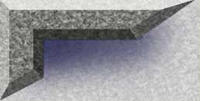Etiology:-
A Radicular Cyst presupposes physical, chemical or bacterial injury resulting in death of pulp followed
by stimulation of epithelial cell rests of malaseez which are present normally
in periodontal ligament.
Pathogenesis:-
Pathogenesis of Radicular Cyst is conveniently considered in 3 Phases, which are as follows
1) Phase of Inititiation,
2) Phase of Cyst Formation,
3) Phase of Cyst Enlargement
1) Phase
of Initiation:- It is generally agreed that the epithelial lining of these cysts are derived from epithelial cell rests of malaseez in periodontal ligaments.
However in some cases, epithelial lining may be derived from ,
a) Respiratory epithelium of Maxillary sinus when periapical
lesion communicates with sinus wall.
b) Oral epithelium from fistulous tract.
c) Oral epithelium proliferating apically from periodontal
pocket.
The mechanism
of stimulation of epithelial cells
to proliferate is not clear. It may be due to inflammation in periapical granuloma or some products of dead pulp may initiate
the process & at same time it evokes an inflammatory reaction.
There is also evidence of local changes in supporting connective
tissue which may be responsible for activating the cell rests of malaseez.
2)
Phase of Cyst Formation:- It is a process by which cavity becomes lined by proliferating epithelium.
There are two Theories regarding it which are as follows:-
a) Most widely accepted
theory suggests that initial reaction leading to cyst formation is a proliferation of epithelial rests in periapical area
involved by granuloma. As this proliferation continues with the epithelial mass increasing in size by division of the cells
on periphery corresponding to basal layer of surface epithelium. The cells of central portion of mass become separated further
& further from nutrition in comparison with basal layer due to which they fail to obtain sufficient nutrition, they eventually
degenerate, become necrotic & liqify. This creates an epithelium lined cavity filled with fluid.
b) The another theory suggest that a cyst may form through proliferation of epithelium to line a pre-existing
cavity formed through focal necrosis & degeneration of connective tissue in periapical granuloma. But the finding of epithelium
or epithelial proliferation near an area of necrosis is not common.
3) Phase of Cyst Enlargement:- Experimental
work provided evidence that osmosis makes contribution to increase in size of cyst. Investigators found that fluids of Radicular
cysts have Gamma Globulin level High by almost more than half to patient’s own serum. Plasma protein exudate & Hyaluronic
acid as well as products of cell breakdown contribute to high osmotic pressure of cystic fluid on cyst walls which causes
resorption of bone & enlargement of cyst.
Microbiology:-
Cyst may or may not be infected. Whenever infection is present
Actinomyces organism have been isolated from radicular cyst commonly.
Microorganisms mainly found in root canal are 75% Gram +ve & 24% Gram –ve, among which Streptococci
are predominant’ also other Gram +ve organisms like Staphylococci, Cornybacterium, yeast & others are found. Gram
-ve organisms are Spirochetes, Nesseria, Bacteroids, fusobacterium, pseudomonas & others.
In Periapical lesions like Radicular cysts Obligate anaerobes
are found.
Additionally in long standing cases of periapical pathology a- hemolytic & non hemolytic streptococci
are found along with obligate anaerobes.
Medias used for Culture of Root Canal Materials - - -
- Brain Heart Infusion Broath with
0.1% Agar
- Trylicase Soy Broath with 0.1%
Agar (TSA)
- Glucose Ascitis Broath

